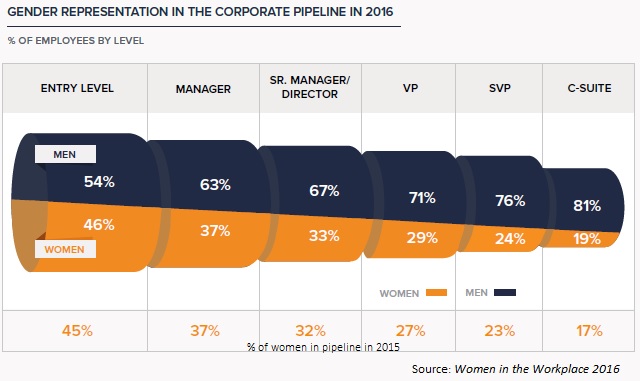This is second of two parts on gender diversity in leadership positions. Today’s article offers some steps organizations can take to develop future women leaders. Part one is here.
————
Between 2015 and 2016, the percentage of women in the corporate pipeline improved, but so slightly there was effectively no change. As the chart shows, women’s representation in the management pipeline falls off substantially the higher up the ladder.

Here are six ways you can help your company develop more female leaders and improve the percentage in your own pipelines:
1. Recognize the potential for unconscious bias
Rather than making it a witch hunt, it’s important to explain that the potential for bias is common but there are ways that companies and methods can identify and combat it. Companies like Paradigm and Textio, for example, are helping major tech companies overcome this challenge by offering training and workshops on implicit bias and opening up their hiring practices to more diverse candidates. Meanwhile Google has come up with its own internal program to help its people recognize unconscious bias. It has also publicly shared the slides and training materials it presents to its employees.
2. Your feedback should be fair and thorough
If you’re unconsciously worried about giving constructive feedback to a female report because you don’t know how they’ll take it, you should consider how you’re saying it. Anyone – whether a man or a woman – who receives strong criticism which isn’t actionable will find it difficult to process. Remember, these key practices: never judge, always refer to specific examples of what was said or done and provide suggestions for how the person could improve.
3. Define top leadership qualities
Without a common and agreed upon set of top leadership qualities, it is more likely that people will hold onto the dominating stereotype of the typical “boss”. Instead, take a page from Google’s Project Oxygen. During this project the company utilized employee surveys, analyzed manager performance reviews and interviewed the top managers within the company. As a result, Google came up with 8 key behaviors that the best managers possess. Not surprisingly, not a single one conformed to the traditional authoritarian stereotype many still unconsciously think of. Instead, some of these included: being a great coach, empowering the team and not micromanaging, and expressing interest and concern for team member’s success and well-being.
Find out what qualities are most important for being a great leader in your company. Make sure this process is inclusive with feedback from employees, peers and managers alike. The better you define what leadership looks like, the less likely future managers will be chosen based on outdated stereotypes.
4. Integrate these qualities into your performance review
It’s not enough to simply come up with a list of behaviors. The next step is then to integrate them into your performance review process as core leadership competencies. Rather than asking if said person has leadership potential, ask people to review others based on their ability to coach, communicate effectively or empower others. This will help both men and women develop the leadership skills needed to effectively manage your teams.
5. Mentoring reports
Rather than making coaching an informal part of a manager’s job, every manager should set up standing bi-monthly 1-on-1s and/or weekly strategic check-ins with each report. By making these 1-on-1 meetings standard for everyone, managers can ensure they’re not unconsciously giving preference to certain employees over others.
6. Tackle imposter syndrome
Though often associated with women, studies show that imposter syndrome affects both sexes. It is a condition generally affecting high performing people. They are convinced their success is an accident and they therefore don’t deserve the recognition they receive.
It could very well be the reason why talented individuals aren’t getting promoted within your organization. To address this common phenomenon, help train your employees to set challenging but attainable goals and teach them how they can use these achievements to benchmark their progress, for themselves and their manager.
For more information on how you can develop your new managers download our free white paper.
